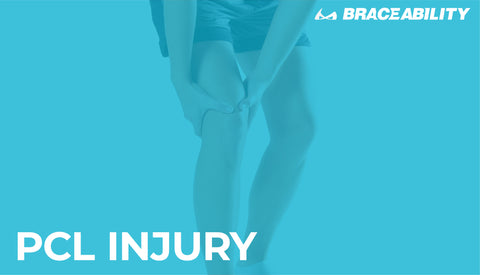Types of Ankle Sprains
Ankle sprains are one of the most common injuries, affecting athletes and non-athletes alike, often leading to significant pain and immobility. Understanding the nuances of different types of ankle sprains can be crucial for effective treatment and prevention.
In this comprehensive guide, we will dive into the various types of ankle sprains, examining their causes, identifying symptoms, and exploring treatment options. Whether you've experienced an ankle sprain or are looking to prevent one, this blog will provide valuable insights into managing and recovering from ankle sprains.
If you're currently recovering from an ankle sprain, enhance your recovery with the Orthopedic Air Walker Boot Cast. This brace is specifically designed to immobilize and protect the ankle, facilitating faster healing for sprains, fractures, and Achilles tendonitis.
By the end, you'll have a thorough understanding of how to recognize and address different types of ankle sprains to ensure a speedy and complete recovery.
Broken vs Sprained Ankle: What’s the Difference?
A sprained ankle results from torn ligaments in your ankle. A broken, or fractured ankle, results from the bone being damaged. An easy way to tell a broken ankle from a sprained ankle is to find where the pain results from. If you press on the soft part of your ankle and feel pain, then your injury is likely a sprain. However, if you press on the hard/bony part of your ankle and feel extreme pain, then you likely have a broken, rather than sprained, ankle.
Sections of the Ankle Vulnerable to Sprains
The ankle has three sections where sprains can occur:
-
Lateral Ankle Sprains
Lateral ankle sprains occur on the outside of your ankle and involve the end of the fibula (the bump on the outside of your ankle). These are the most common types of ankle sprains, in which the ligaments that stop your foot from rolling outwards suffer injury.

-
Medial Ankle Sprains
Medial ankle sprains refer to injuries on the inside of your ankle. The medial, or deltoid ligament, is a strong band of connective tissue that helps stabilize the inner ankle. A medial ankle sprain occurs when the ankle is stretched beyond its normal range of motion, and the ligament fibers are stressed or torn.

-
High Ankle Sprains
A high ankle sprain occurs when the ligaments above the ankle joint, that connect the tibia and fibula, are torn, stretched, or damaged. High ankle sprains are less common and more severe than the other types of ankle sprains. They often are caused by a strong force or a sudden and excessive twist. Dealing with a high ankle sprain? The Ankle Arthritis Brace offers tailored support for lateral pain, high sprains, and more. The lace-up design provides customizable compression and stability, aiding in rehabilitation and preventing further injuries, all while speeding up recovery time.

Recognizing and Managing Types of Ankle Sprains
There are two types of ankle sprains, inversion and eversion sprains, that can occur in any of the three sections mentioned above. Their difference is in which way the ankle rolls when it is injured.
Inversion Ankle Sprain
The most common type of ankle sprain is the inversion ankle sprain. It occurs when the foot rolls inward and twists upward at the same time - damaging the ligaments on the outside of the ankle.
Symptoms of an inversion sprain include pain on the outside of the ankle, swelling, bruising, and tenderness, leading to instability in the ankle joint.
Eversion Ankle Sprain
Eversion sprains occur when the ankle rolls outward (instead of inward like the inversion sprain), resulting in torn ligaments.
Similar to inversion sprains, symptoms of eversion ankle sprains include swelling, tenderness, pain, loss of motion, loss of function, and possibly an unstable joint. However, an eversion ankle sprain specifically results from the ankle rolling outward, which can cause injury to the deltoid ligament on the inner side of the ankle.
To differentiate between an eversion ankle sprain and a torn ligament, it's crucial to examine the pain's location and intensity. In an eversion sprain, the pain is usually felt on the inner side of the ankle and is associated with swelling and bruising in that area. If the deltoid ligament is torn, the pain will be more severe and concentrated, often accompanied by significant swelling and difficulty bearing weight on the affected foot.
Additionally, a torn ligament may lead to a noticeable instability in the ankle joint, making it difficult to perform everyday activities without discomfort.
Effective Treatments for Ankle Sprains: Understanding Severity and Care Strategies
No matter where the ankle sprain occurs (high, medial, or lateral), the severity is graded on a three-tier system, grade I ankle sprains being the least severe and grade III being the most severe. The severity will determine the best course of treatment for healing the sprain and getting back to life.
The Ankle Stabilizing Orthosis Brace provides crucial support and pain relief for rolled, sprained, or twisted ankles. This Figure-8 design helps stabilize the joint, making it a trusted choice for athletes and individuals with chronic ankle instability.
Between all three grades of sprains, one of the best treatment methods directly following the injury (and for any subsequent days, depending on pain levels) is the R.I.C.E. method. Rest, ice, compress, and elevate the ankle to promote a speedy recovery.
Grade I Ankle Sprains
Grade I ankle sprains are the least severe ankle sprains. Minimal swelling and tenderness should be expected, as well as some pain. The ligaments are microscopically torn, so treatment can be relatively quick - the ankle and be weight-bearing as tolerated, and full range of motion can be returned to when pain allows.
Grade II Ankle Sprains
Moderate tenderness and swelling can be expected with grade II ankle sprains. Paired with this is a decreased range of motion as well as possible instability. Grade II sprains can be fairly painful because some, but not all, of the fibers in the ligaments are completely torn. Immobilization using an ankle splint is recommended, paired with physical therapy focused on range of motion stretching and strengthening exercises.
Grade III Ankle Sprains
Grade III ankle sprains are the most severe - they can be expected to have significant swelling, tenderness, and instability within the joint. This is caused by a complete tear of the ligament. A good treatment course is immobilization until a physical therapy routine can be tolerated. The physical therapy is similar to grade II sprains - but over a longer period since the injury is more severe. In some extreme cases, reconstruction surgery may be needed.

Recovering from Ankle Sprains: Next Steps and Tips
No matter which type of ankle sprain you may have, it is important to take it easy on that ankle for a while. Paired with the R.I.C.E. method, physical therapy is a great option to get you well on your way to recovery. Remember, if pain doesn’t subside within 3-6 weeks, it is best to see your doctor to rule out a break in the ankle bone.
Whether you're back to training or need ongoing support, the Elastic Ankle Brace is ideal for gymnastics, dance, and athletic activities. This lightweight and breathable brace offers comfort and stability, helping you perform at your best while minimizing the risk of future injuries.
By taking proper care and following a structured recovery plan, you can ensure a swift return to your daily activities and maintain long-term ankle health. Taking proactive steps during recovery can significantly reduce the risk of future ankle injuries and ensure a swift and complete recovery process.










